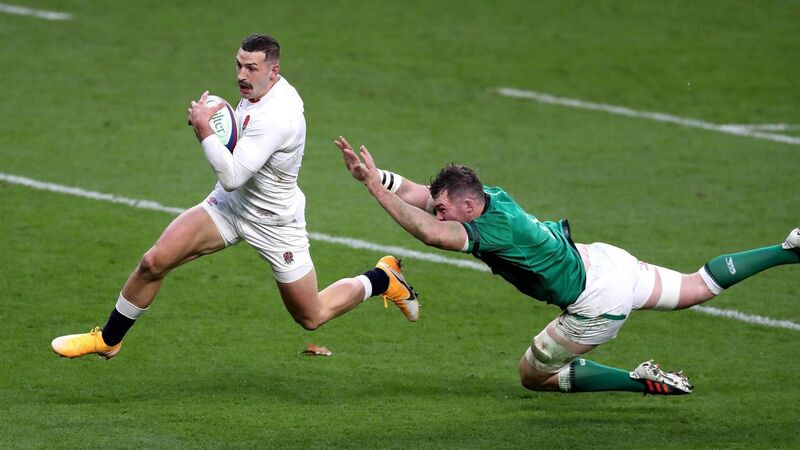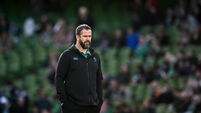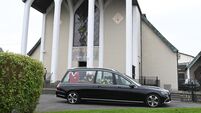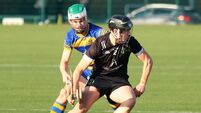Donal Lenihan: Andy Farrell and Ireland fall for Eddie Jones’ rope a dope

Jonny May races away from Peter O’Mahony to score his and England’s second try during in the Autumn Nations Cup match at Twickenham on Saturday. Picture: David Rogers - RFU/The RFU Collection via Getty Images
The frequency with which Kerry appeared in All-Ireland football finals during their ‘golden years’ prompted an oft-used line from Kingdom great Ger Power. Hounded by the media for a juicy quote in advance of his latest final appearance he said “just put me down for what I said last year”.
I thought of Power in advance of this clash against our oldest rivals in Twickenham on Saturday and was tempted, when contemplating my analysis of this latest head to head, to tell the sports editor to “just put me down for what I wrote after the last game between the sides”.
Whilst the outcome was the same — a fourth successive win on the bounce for England — you were left with the feeling that things could have been far worse from an Irish perspective. Andy Farrell was left clutching at straws in his post-match interview when pointing out that Ireland won the second half, outscoring England 7-6.
That was scant consolation and due, primarily, to a lack of real ambition and a more ruthless streak from the hosts. You left with the impression that perhaps, with a trip to Dublin for another Six Nations head to head only four months down the line, England decided to place more emphasis on their defence than on their attacking prowess. Time will tell.
If certainly felt as if England had set their stall out on stressing Ireland without the ball rather than with it. Despite the try conceded to Jacob Stockdale, courtesy of a delightful chip in behind England’s hard-hitting midfield from Billy Burns, England gave a masterclass in the art of defending and denying the opposition space.
It’s as if England coach Eddie Jones has set out in this Autumn Nations Cup campaign looking to major in a key aspect in every game. Against Georgia the previous week, England concentrated a huge amount of their efforts in perfecting their scrum and lineout maul.
This time out, with Ireland dominating possession and territory to an alarming degree, England choose to suffocate Ireland’s attack, registering a scarcely believable 238 tackles, with just nine missed, for a 96% completion rate. That is off the charts.
Normally a side having to make that many tackles over 80 minutes would be completely out on their feet. England never dropped their intensity, even if they played very little rugby, which is frightening. By way of contrast, Ireland had so much possession they only had to make 72 tackles but only had a completion rate of 87%, having missed 11.
It’s what Ireland did with that possession that will tax Farrell and his attack coach Mike Catt most. It was rugby’s equivalent of rope a dope. If you continue to run into brick walls, or in this case an impregnable white wall of England defenders spread right across the pitch, you will eventually knock yourself out.
When analysing games against England these days, you end up revisiting the same key strengths that have become central to the way they play. Jones is building a clear identity around what English rugby represents and, while it might not be aesthetically pleasing, it is proving hugely effective.
You know in advance that they are going to stress you in the back field with the accuracy of their kicking game, made all the more effective by the quality of the chase. They also look to drive you back in the contact area, chase turnovers at the breakdown and dismantle your set piece.
While Ireland’s scrum did come under pressure, it survived relatively intact with Andrew Porter putting in an incredible 80-minute shift in the absence of Tadhg Furlong. With Furlong on board, your scrum becomes an attacking weapon. Without him — unless you are playing Wales — it’s only a means to restart the game.
Once again England dominated at the breakdown and slowed Ireland’s recycle to a snail’s pace. That bought time for the England defenders, coming from the outside in, spooking Ireland’s ability in attack and forcing them into contact. There was only going to be one winner there.
One of the biggest concerns for the Irish coaching ticket surrounds the failure of the lineout to function in the opposition 22. Unfortunately this is becoming an all to regular occurrence. Playing against the top sides, like France and England, you have to be 100% accurate in the scoring zone.
Against France in Paris last month, Ireland were turned over in three key attacking lineouts. This time out it was even worse with Jonny May plunging a dagger to the heart by scoring an incredible 100-metre solo try, his second in a four-minute spell that ultimately decided the match, off an overthrow 10 metres from the England line.
For all of England’s conservatism in attack, they recognised the space available out wide and immediately got the ball into the hands of their fastest player. Chris Farrell was checked and caught on the outside by the flying Gloucester winger and not enough Irish players reacted quickly enough to the turnover.
While effective against a substandard Welsh front five in Dublin, Ireland’s lineout maul has failed to inflict any damage on the well structured defensive maul adopted by France and England. In comparison to where we were in the Joe Schmidt era, Ireland’s lineout and maul efficiency has gone backwards and needs a radical overhaul.
Given that England have averaged 4.5 tries a game against Ireland in the four tests played since that magnificent 2018 Grand Slam win in Twickenham, Farrell will take some solace from the fact that only two tries were conceded this time out. He can also point to the fact that, while England fielded their strongest available side including 11 starters from their 2019 World Cup final team, Ireland were in a more experimental mode.
Nowhere was this more evident than in the respective half-back pairings where Jamison Gibson-Park and Ross Byrne, with 11 caps between them, battled against the odds against Ben Youngs and Owen Farrell with a combined 186 caps. Given the pressure England applied at the breakdown, that was always going to be telling.
Having had an armchair ride behind a dominant pack against Wales last time out, Gibson-Park faced a totally different experience with very little quick ball on offer. That’s what England do, with their brand of pressure rugby forcing you into indecision.
England return to Dublin in the final round of Six Nations action on March 20 next and there’s every chance they will be playing for another championship that day. Farrell will have to find a remedy for countering what they bring to the table, otherwise the outcome will be the exact same. The clock is ticking.

Unlimited access. Half the price.
Try unlimited access from only €1.50 a week
Already a subscriber? Sign in









